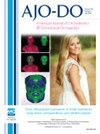热成型和三维打印正畸矫正器的吸收和解吸动力学。
IF 3
2区 医学
Q1 DENTISTRY, ORAL SURGERY & MEDICINE
American Journal of Orthodontics and Dentofacial Orthopedics
Pub Date : 2025-05-14
DOI:10.1016/j.ajodo.2025.04.022
引用次数: 0
摘要
正畸矫正器的机械性能和配合程度受其与口腔环境中水分的相互作用的影响。本研究旨在评估和比较热成型(Invisalign [Align Technology, Santa Clara, Calif .]和ClearCorrect [Institut Straumann AG, Basel, Switzerland])和三维(3D)打印(Tera Harz TC-85, Clear A;Graphy Inc .,首尔,韩国)正畸矫正器。方法:按品牌和制作方法对32个矫形器进行分类。样品在37°C蒸馏水中浸泡14天,每天称重。脱附测定每小时间隔8小时,去除浸渍后24小时测定一次。基于菲克扩散理论,采用对数-对数变换数据和线性回归对扩散动力学进行建模。结果:所有材料均符合Fickian扩散曲线。在第14天,热成型牙齿矫正器的吸水性明显高于3d打印牙齿矫正器(Invisalign为4.91%,Clear A为2.76%;结论:矫正剂的制作方法和材料组成对水分动力学有显著影响。热成型矫正器,特别是那些外层有热塑性聚氨酯层的矫正器,表现出更大、更快的水相互作用,而3d打印矫正器的整体吸收率较低,但释放延迟。这些差异可能会影响矫直器的配合和临床表现。本文章由计算机程序翻译,如有差异,请以英文原文为准。
Absorption and desorption dynamics of thermoformed and 3-dimensional-printed orthodontic aligners
Introduction
The mechanical performance and fit of orthodontic aligners are influenced by their interaction with moisture in the oral environment. This study aimed to evaluate and compare the water absorption, desorption kinetics, and diffusion behavior of thermoformed (Invisalign [Align Technology, Santa Clara, Calif] and ClearCorrect [Institut Straumann AG, Basel, Switzerland]) and 3-dimensional (3D)-printed (Tera Harz TC-85, Clear A; Graphy Inc, Seoul, South Korea) orthodontic aligners.
Methods
Thirty-two aligners were divided by brand and fabrication method. The samples were immersed in distilled water at 37°C for 14 days and weighed daily. Desorption was measured at hourly intervals for 8 hours and once at 24 hours after removal from immersion. Diffusion kinetics were modeled using log-log transformed data and linear regression based on the Fickian diffusion theory.
Results
All materials followed Fickian diffusion profiles. Thermoformed aligners showed significantly higher water absorption than 3D-printed aligners by day 14 (4.91% for Invisalign vs 2.76% for Clear A; P <0.001). Invisalign also exhibited the highest diffusion slope (k = 0.74) and the fastest desorption (93.7% in the first hour). Three-dimensional-printed aligners displayed slower early desorption but reached comparable release at 24 hours. A strong correlation was observed between water absorption and early desorption (r = 0.903; P <0.001).
Conclusions
The aligner fabrication method and material composition significantly affected the moisture kinetics. Thermoformed aligners, especially those with outer thermoplastic polyurethane layers, demonstrate greater and faster water interactions, whereas 3D-printed aligners offer lower overall uptake but delayed release. These differences may influence the aligner fit and performance in clinical settings.
求助全文
通过发布文献求助,成功后即可免费获取论文全文。
去求助
来源期刊
CiteScore
4.80
自引率
13.30%
发文量
432
审稿时长
66 days
期刊介绍:
Published for more than 100 years, the American Journal of Orthodontics and Dentofacial Orthopedics remains the leading orthodontic resource. It is the official publication of the American Association of Orthodontists, its constituent societies, the American Board of Orthodontics, and the College of Diplomates of the American Board of Orthodontics. Each month its readers have access to original peer-reviewed articles that examine all phases of orthodontic treatment. Illustrated throughout, the publication includes tables, color photographs, and statistical data. Coverage includes successful diagnostic procedures, imaging techniques, bracket and archwire materials, extraction and impaction concerns, orthognathic surgery, TMJ disorders, removable appliances, and adult therapy.

 求助内容:
求助内容: 应助结果提醒方式:
应助结果提醒方式:


